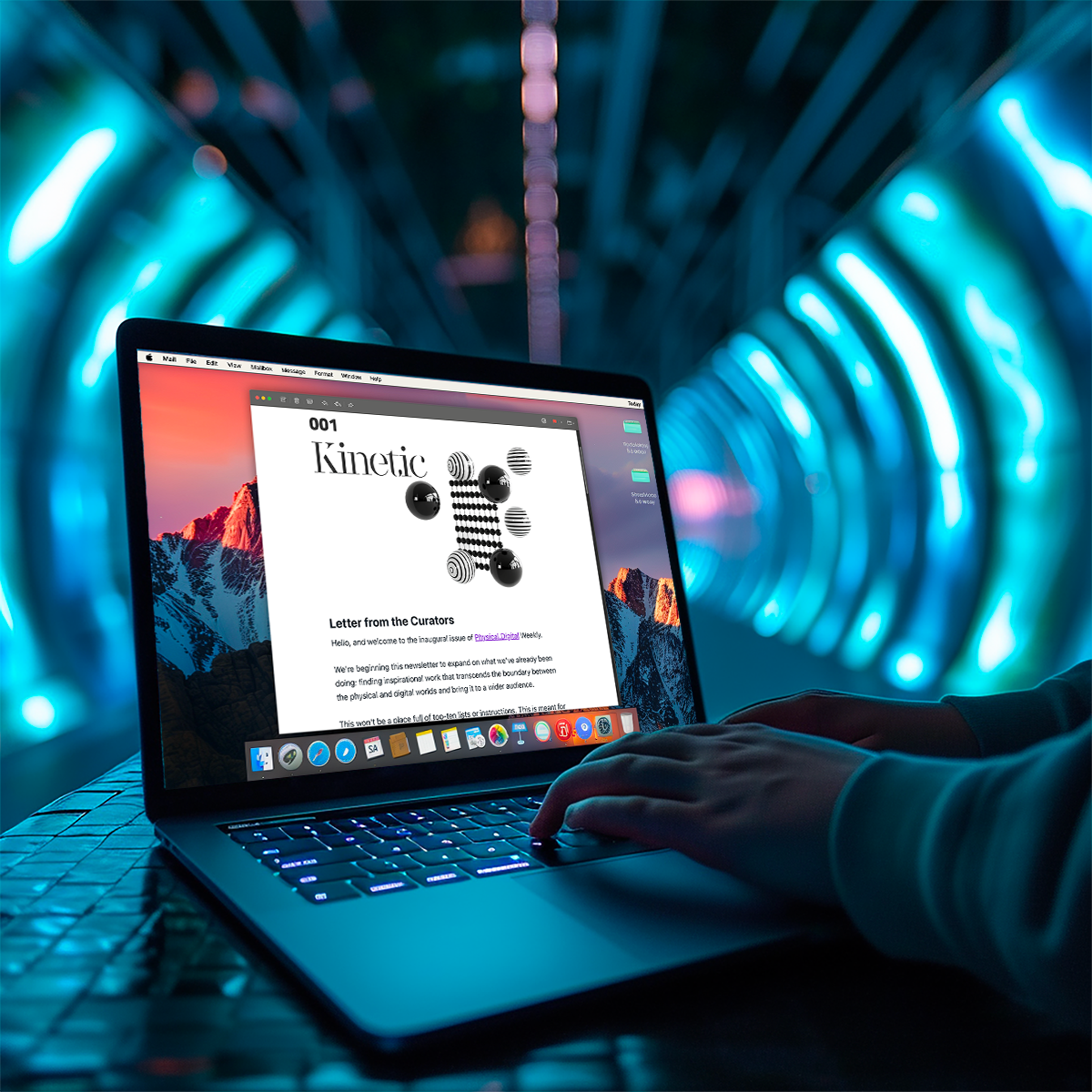Playmodes
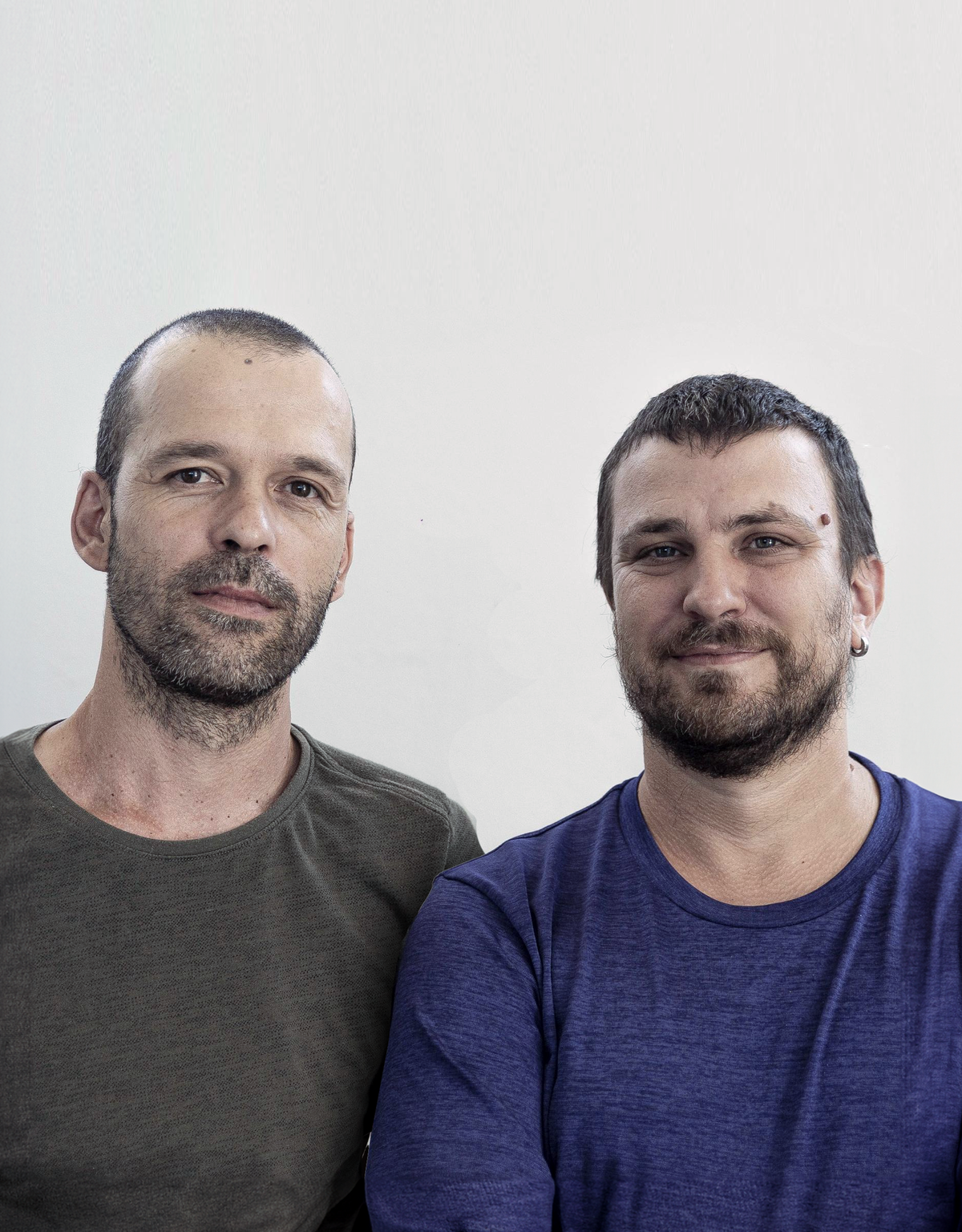
A conversation with
Playmodes
Eloi Maduell (left) and Santi Vilanova (right) have worked together for 20 years from their studio in Spain. They joined us to discuss collaboration and designing for the senses.

Your work together spans two decades. When you look back, what are you most proud of?
I'm still playing with technology, enjoying myself, and doing exactly what is my passion
Eloi: We were discussing this question earlier and we have different points of view, because it's kind of a personal question. Playmodes is me and Santi and we are two different universes. Sometimes we match and sometimes not.
I'm most proud that I am able to be here.
When we started, we didn't know exactly what the fuck we were doing. We just liked pushing inwards, experimenting with new media, real-time video, etc. During this time, we were building Playmodes, but being able to see that, after 20 years, I'm still playing with technology, enjoying myself, and doing exactly what is my passion—that's what I'm mostly proud of. (Or that I’m able to survive in this world by doing blinking lights. That's amazing.)
Santi: For me, more than highlighting projects or specific things, it's all that we learned during all these years. I was trained as a graphic designer in university 20 years ago. I knew a lot about typography and illustration, but I didn't have a clue about new media, or programming, or the engineering side of it all.
Because we've been integrated into the open source community, with this idea of do it yourself, we learned a lot. We learned electronics engineering, not because we were studying it in the university, but because we wanted so bad to make something happen that we had to learn to do it. We learned about software programming, how to write a score for instrumental musicians, how to develop a business. Maybe that's the boring part, but it's also valuable.
Also all the friends that we met along the way. We've been able to travel and go to many festivals and meet crazy people like us, which have become friends that we regularly meet now.
Beyond is also a tale of the collision between 2 forces: inner and outer, darkness and light, death and life. Waves of light and sound, crafted through self-made software, drive an immersive experience inside this 35m long tunnel.
Do you feel that you are two separate artists working together, or is it impossible to separate yourselves as a single creative force?
It's a very tight relationship where we don't need to agree on everything. But when we can complement each other, it’s very beautiful.
Eloi: Whatever we like to do, personally or together, Playmodes acts as an umbrella which we can develop under. Sometimes we need to get closer to develop something together. Sometimes there’s a path I want to explore, and under Playmodes, it’s ok, I can go in my direction.
We don't have this firm path, like Playmodes cannot do this because it is this type of entity. We don't like to have this pressure. It's the union of me and Santi during a lot of years. And that has a lot of outcomes, and we are proud of all of them. For example, I love what Santi is doing with his instrumental music he's been developing. And sometimes we need each other for the work, and sometimes not.
Santi: We each have our areas of expertise, and there are places where we need to work together and that we both love. I don’t have a background in music composition, and even though it seems like something far away, it’s complementary. So maybe there's a moment that I want to write a score for a string quartet, and the cool thing is that Playmodes can be an umbrella for that. I can make that project and it can be signed as a Playmodes project, and that's super beautiful.
The same thing happens for Eloi’s projects and his areas of expertise. It's like a marriage. We know each other longer than our wives! We have developed a secret language between us, where we say some words that no one else knows what they mean, but we understand perfectly.
It's a very tight relationship where we don't need to agree on everything. But when we can complement each other, it’s very beautiful.
At the end, I think that is the key to our success. If both of us didn’t feel free to do anything under Playmodes, then it would have disappeared 10 or 15 years ago. Freedom is the key.
Signes behaviors are generative on its nature. Due to randomness, chance and probability, the graphic/kinetic/sonic behaviors of the piece are never repeated exactly the same, and although there is a deterministic order on how the sets of rules are to be sequenced, the exact results are unpredictable.Signes behaviors are generative on its nature. Due to randomness, chance and probability, the graphic/kinetic/sonic behaviors of the piece are never repeated exactly the same, and although there is a deterministic order on how the sets of rules are to be sequenced, the exact results are unpredictable.
A lot of artists say that they are driven by the need to tell a story. Do you find that this is true for you?
Eloi: We don't feel that we need to tell stories in the classical way of a story, with characters and plot and the typical structure. We do have some narrative but it's more abstract. We say it’s a perceptual narrative or history. We like to build stories, but they are more abstract. It's something that you can feel.
We work more on an emotional level, developing intensity and drama, and what we want to express is not easy to say in words. It's something that you have to experience. Sometimes we affect the senses very powerfully, and that's our narrative.
We want to create an abstract language which can be recognizable by everyone, anywhere, and not have the need for words or translation for people to recognize.
In 2000 I was a VJ, and Santi was into electronic music. So we started finding ways to complement and experiment, and we’re still doing that with the Audio-Visual language. We don’t care if it’s projection mapping, or video, or lights—we want people to feel it.
Santi: Are we Rothko or Kandinsky driven by the need to tell story? I don’t think so. Like Eloi was saying, it’s generating an experience, or mood, or some kind of intensity or mystery. This idea of developing an audio visual language is something that we love. Maybe it’s a little weird, but it's like Close Encounters of the Third Kind. We're aiming for this idea of a universal language, which is made by single abstract cells of color, and musical tones. We want to create an abstract language which can be recognizable by everyone, anywhere, and not have the need for words or translation for people to recognize.
Eloi: That's why we have been pushed to work with light itself, leaving behind video production. We have always liked a storyboard and concepts, but it’s very abstract.
“FORMS – String Quartet” is a live multimedia performance for string quartet, electronic music and panoramic visuals, based on the concept of “graphic sonification”.
Santi: We feel like light and sound are exactly the same thing. It's all about vibration.
Recently there was this discovery of a star system where all planets were in harmony, something called orbital resonance. Meaning that for each three orbits of one planet, the next orbits exactly twice.
For us, that's like color, or music, it's all related. Our ideas of these comparisons between music, light and everything else in the universe. So sometimes it's very deep, like brightness in light equals the volume in sound. If something is very bright, it should be very loud, and if it's totally dark, it should be totally silent. Or if something is moving fast, it’s logical that it makes a higher sound.
Our process is very much based on observation of nature, more than telling a story with characters and so on.
Eloi: When you see something like lightning, there's a relationship, a connection of senses. that’s the kind of thing we’re trying to reproduce.
Can you share your process for Astres which you’ve revisited and built on for years?
Eloi: We knew that at the end what we want to do is create an immersive experience. The big immersive experiences that we had growing up was sitting down in the grass in the mountains and looking at the sky. We liked the idea of building on top of that, and making an audio visual language without a screen.
From the beginning, we knew the potential of the precise lasers that we were developing with, but also that the path of developing the technology was really hard.
In most project, we look back and realize we had just a glimpse of the end. Every project is like a different instrument. We just learned to play the first notes but we didn't make a masterpiece with this instrument, that was impossible. So we must go step by step and try to enjoy the process, because at the end—when we are saying what we are proud of is what we learn—being able to learn gently and know what steps you're going to do next is important, not driven by pressure of having a project ready.
In the case of Astres, this is going to be a project that might finally end in 30 years. Then we'll be able to say okay, now we've made everything that we want to do with the stars and a laser. We're starting to go closer to what we want to do, but it's so immense and there are so many narratives talking about the many things that happened in the universe.
When you invent the brush, do you know all the possible outcomes that this brush is going to give?
Santi: We still don't know what is the final form of it. We have some ideas, but we also are working with organic media. We’re asking ourselves why don't we use organic instruments instead of using electronic music? Why don't we put up an acoustic piano in the middle of the fields, but we still don't know exactly where we're going to be and I think this is very much related to this idea that it's not that we play instruments, it's that we also build them.
So to reformulate the question: when you invent the brush, do you know all the possible outcomes that this brush is going to give? So know that the brush can give birth to an infinite number of paintings. We have some restricted ideas of the possibilities of this creative technology, but I think the possibilities are kind of endless.
Eloi: That's a bit the definition of Playmodes. The idea of Playmodes is that when you start developing an instrument, you have an idea and you make the first step, but then there's a new branch here and a new branch there. You start exploring that and you think about one mode, and then you have three modes, and more and more. We like to discover these new possibilities that emerge.
Astres right now is still open in many directions. But all of them are promising.
Santi: Development is part of the creative process. When we start a creative project, software or hardware development is very much part of the creative process, exactly the same as selecting a color or choosing musical scales. Developing an algorithm with code is not different than making any other creative decision.
An ongoing "research" project starting in 2020, Astres maps the stars with lasers.
What do you see as the future of physical and digital convergence?
A magic spell is like text sequence, a vocal sequence which alters reality.
Santi: Personally, I prefer something really physical, not like a painted surface, like the Van Gogh experience. We love the idea of something that is using the three dimensional space, not just bouncing on a surface. You want the vibration of subwoofers and the haze in the atmosphere and that's why we love working with lasers and smoke, because that makes it possible for us to create three dimensional geometry in the atmosphere.
With projection, you can put your hand on it and block the light for those passing by and that's the end. We talk a lot about sculptural projects made with stones and made with ropes, made with physical things and using all that we learn in the digital domain to transform reality. I see it as a bit like magic.
What is a magic spell? It’s parallel to code. A magic spell is like text sequence, a vocal sequence which alters reality. Code is the same, it gives you the same kinds of powers, it’s some lines that transform reality. At the end, our ultimate aim is to transform physical reality as much as possible. And not just surfaces or screens or glasses, but the physical space.
Eloi: We like to intervene in the physical world, but without an interface, or rather the interface is you and the reality around you.
Immersive installations like Van Gogh, or things like that, okay, it's big projections. It’s like virtual reality in the real world, but it doesn't work. So we prefer to work with physical phenomena that affect you.
It's very difficult to say what's the future for physical digital. I would say my first answer was nature. Technology is very nice, but nature is so much more.
VJYourself! is an interactive dance installation, the users dance with themselves in the past, repeated, composed and choreographed by time and repetition effects.
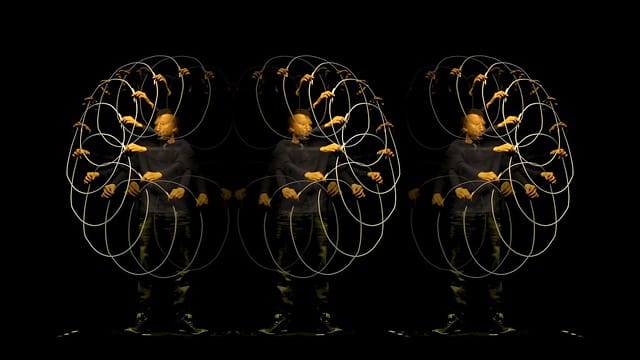
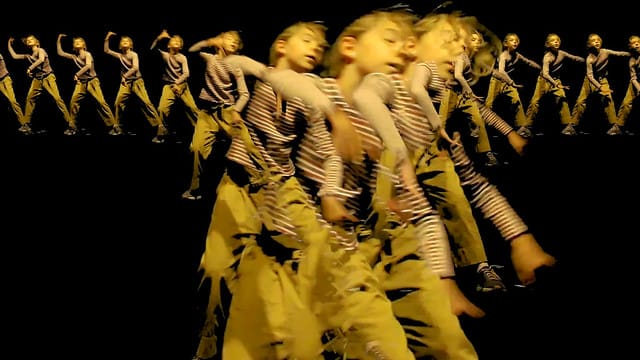
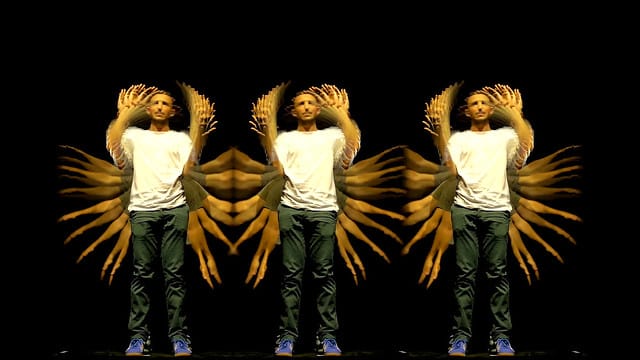
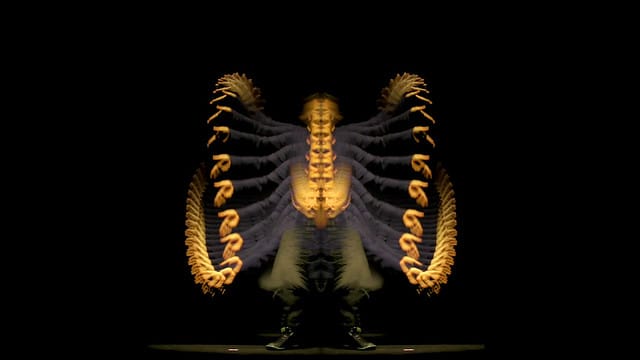
What are you working on now?
Santi: In two weeks I’m going to the Goodman Musical Instrument Competition in Georgia to share a project called Sonograf we created. It’s a physical instrument we made for primary schools here in Spain. Children can make their drawings using markers or pencils or whatever, and this machine, or instrument, automatically transforms the children's drawings into music. So they are actually drawing visual scores. This isn’t a project we sell, but it’s one we’re proud of.
Eloi: We’re also working on an installation called VJ Yourself, which was actually originally called Playmodes and was the installation that made us start working together more seriously. It’s a camera live capturing a user dancing, combining the real time with the past of the user, making a choreography of you with yourself.
This project started in 2024, when Zachary Lieberman came to Barcelona to present openFrameworks. It’s a playful project, just a game for people to enjoy themselves and to make crazy compositions.
Santi: We're preparing this exhibition in ZFIL in Germany. I think it’s the only specialized Museum in Europe about light art, and it's in a small city called Uuna. We’re going to show Signes, which plays with robotic lights, and it will be exhibited there for six months.
It’s a great museum where there's James Turrell, Rebecca Horn, Olafur Eliasson and others in the collection. We are super proud to be featured among these giants.
The “Sonògraf” is an electronic audiovisual instrument. Thought as a music learning tool for primary schools, it allows the drawing to be transformed into music, turning gestural strokes and geometric figures into electronic sounds.

